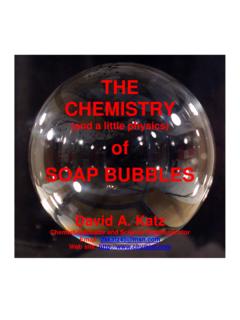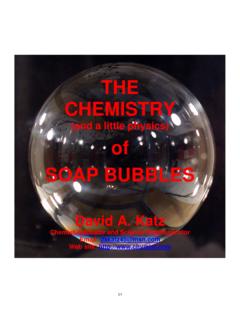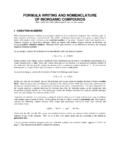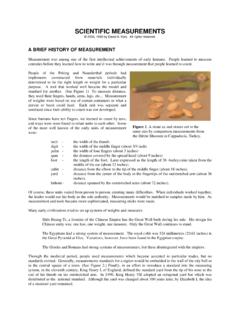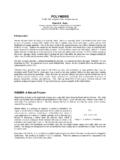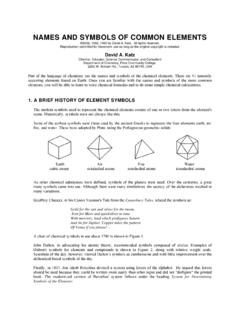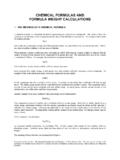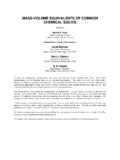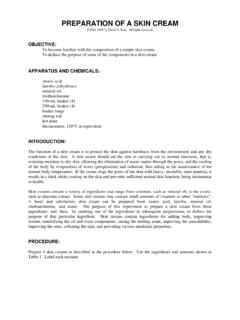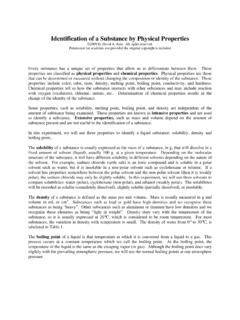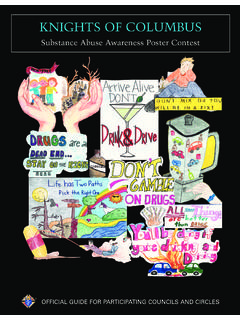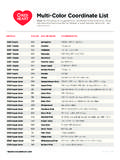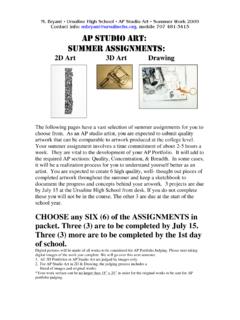Transcription of Making Wax Crayons - chymist.com
1 Making Wax Crayons 2011, 2010 by David A .Katz. All rights reserved. Modern Crayons are combination of pigment and wax. The origin of the word crayon is believed to go back to 1644, a diminutive of the French word craie (chalk) and the Latin word creta (Earth). The use of pigment mixed with wax has been traced back to the Egyptians who used a technique of combining hot beeswax with colored pigment to bind color into stone in a process known as encaustic painting. The image was fixed in place by heating. A similar method was used by the Romans, the Greeks and indigenous people in the Philippines around 1600-1800.
2 Crayons , in a form which can be held and colored with are purported to have originated in Europe. Some of the first cylinder shaped Crayons were made with charcoal and oil. Pastels, composed of chalk and pigments are an art medium having roots with the modern crayon and stem back to Leonardo da Vinci in 1495. Cont Crayons , used in Paris, a hybrid between a pastel and a conventional crayon were used since the late 1790s as a drawing crayon for artists. Various hues of powdered pigment eventually replaced the primary charcoal ingredient in the early 1800s product.
3 Joseph Lemercier (1803 - 1884), considered by some of his contemporaries to be the soul of lithography was also one of the founders of the modern crayon. Through his Paris business circa 1828 he produced a variety of crayon and color related products. But even as those in Europe were discovering that substituting wax for the oil strengthened the crayon, various efforts in the United States were also developing. The initial era of wax Crayons saw a number of companies and products competing for the lucrative education and artist markets. In addition to the giants like Binney & Smith, makers of Crayola, and American Crayon makers of Dixon Ticonderoga, other companies popped up in the industry at various times from the late 1800s to the early 1910s.
4 Materials needed Paraffin wax Beeswax Stearic acid, CH3(CH2)16 COOH (available from chemical supply companies or craft stores) Pigments for coloring wax (available at art stores) Wood craft sticks (popsicle sticks) Large, clear soda straws, cut in half Small aluminum foil baking dishes or cups Non-hardening modeling clay Knife or single edge razor blades Hot plate Newspaper of other material to protect the tabletop Optional: Candy molds to make shaped Crayons Cooking spray Safety precautions Melted wax is flammable. Do not heat at a high temperature. Caution, wax will be hot. Wear insulated gloves or protect your hands with several layers of paper towels.
5 If a knife or razor blade is used to remove finished Crayons from the soda straws, take care to protect your hands from possible cuts. Procedure Each lab group will prepare one color of crayon using the formulations below. Wax formulations: Formulation 1: 7 g paraffin wax, 7 g beeswax, and g stearic acid Formulation 2: 5 g paraffin wax, 9 g beeswax, and g stearic acid Formulation 3: 9 g paraffin wax, 5 g of beeswax, and g stearic acid Formulation 4: 14 g paraffin wax, and g stearic acid Obtain a small aluminum foil baking dish or cup. Crease the edge to make a pouring spout. Measure wax according to one of the formulations, above.
6 Place in a small aluminum baking pan. Heat the wax on a hot plate set at medium-low heat. (about one-third of the heat setting). Stir with a wood craft stick to melt evenly. Plug one end of a straw with modeling clay, using enough excess clay so that the straw will stand upright. Prepare two soda straws for each formulation while the wax is heating. Place the straws on a sheet of newspaper or other material to protect the tabletop. Optional: If candy molds are available, you can make shaped Crayons (See notes the follow this procedure.) . Add g of pigment to the melted wax.
7 Stir to obtain a uniform color. If the color is too light, additional pigment can be added. Remove the aluminum pan from the heat. Use tongs or several layers of paper towels to insulate your hand from the hot pan, and carefully pour the wax mixture into the soda straws. Allow the wax to harden for about 15 Remove the Crayons from the straws. If the crayon does not come out of the straw easily, use a knife to slit the side of the straw. Label the Crayons Repeat the procedure with a different wax formulation. If a pointed end or the Crayons are desired, sharpen carefully in a pencil sharpener. (A small hand-held pencil sharpener is preferred.)
8 Do not use an electric sharpener.) Once you have a formulation that produces a crayon that you like, you can make additional Crayons of different colors and use molds to make shaped Crayons . Notes: When using molds to make shaped Crayons , spray them lightly with a non-stick cooking spray or silicone spray. After pouring wax into molds, it is important to allow the wax to cool and harden completely. Reference Weber, Linda and John Mauch, Teaching Chemistry with Art, ChemEd 2005 Questions 1. Compare the Crayons made from the different formulations of the wax with regard to color, texture, and ease of use.
9 2. Which formulation produces the best Crayons ? 3. Do the different pigments produce different results?.
